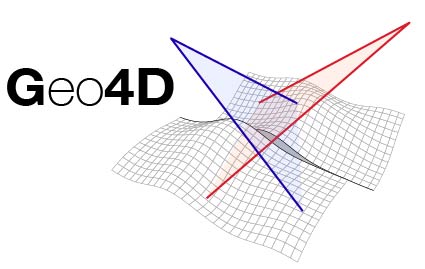5. Setup and formating for KF¶
5.1. Prepare inputs¶
5.1.1. Format¶
KFTS-InSAR reads an HDF5 file containing the interferogram stack. It can contain the following dataset, although other format are suported, for N interferograms of (Y, X) pixels linking M acquisitions:
Jmat Dataset {N, M} Connectivity matrix [-1,1,0]
bperp Dataset {N} Perpendicular baseline array (not used by KFTS yet)
dates Dataset {M} Array of ordinal values for SAR acquisition dates
figram Dataset {N, Y, X} Array of interferograms
tims Dataset {M} Array of SAR acquisition times in decimal years
Note
KFTS is able to read MintPy ifgramStack file without the use of the prepare_input.py routine
5.1.2. Prepare input interferogram stack [optional]¶
Preprocessing only useful if the HDF5 file discribed above has to be constructed. Functions are optimized for ISCE architecture.
- class prepare_input.BuildStack(verbose, ylims, xlims)[source]¶
Quick class to deal with stack of interferogram
- ConnectMatrix(dates)[source]¶
Gets the connectivity matrix for given set of IFGs. Args:
dates -> List of pairs of strings
- Returns:
Uts -> Unique dates of acquisitions
connMat -> Connectivity matrix (1,-1,0)
- deramp(data, out, network=True, poly=3, dref=[(0, 0)])[source]¶
Network deramping of the stack of interferograms. Used when no GPS is available.
- Args:
data Input stack object (interferograms)
out Output stack object (dataset will be overwritten)
- Kwargs:
network Network deramping or individual deramping
poly Polynomial code for deramping
- dref Coordinates of points delimiting a polygon taken
as the reference region for estimating a ramp (list of 2-tuple)
- findramp(phs, mask)[source]¶
Estimate the best-fitting ramp parameters for a matrix. Args:
phs - Input unwrapped phase matrix.
mask - Mask of reliable values.
- poly - Integer flag for type of correction.
1 - Constant 3 - Plane 4 - Plane + cross term
- Returns:
ramppoly - Polynomial corresponding to the rank
- class prepare_input.GetConfig(configfile)[source]¶
Class to run read config file and keep everything in object
- prepare_input.getBaselines(baselineDir, masterDate)[source]¶
Get baseline values from baseline files.
- prepare_input.getPairs(igramsDir)[source]¶
Get the two dates of each interferogram produced by ISCE, in Igram directory.
5.2. Read and formate data¶
Processing steps contained in the main KFTS-InSAR routine.
- class kf.readinput.SetupKF(h5file, fmt='ISCE', comm=False, mpiarg=0, utime='years', verbose=True, subregion=None, cohTh=None, refyx=None)[source]¶
- Class for reading and modifying interferograms for Kalman filtering.
- h5file:
.h5 file path containing
time : decimal dates relative to first acquisition (usually in years)
dates : absolute data
igram : interferograms
links : connection between phases to build interfero (M x N), 0 1 and -1
bperp : perpendicular baseline between aquisitions (not exploited yet)
- Opts:
- fmt:
format of H5file input, default is ‘ISCE’ (also ‘RAW’ ‘MintPy’)
- comm:
do you use parallel features of mpi4py (True or False, default False)
- mpiarg:
precise rank and size of communicator (tuple used if mpi=True)
- utime:
time unit as string (years or days)
- verbose:
print stuff? (True or False)
- subregion:
subregion class instance containing x and y bounds as pixel numbers
- cohTh:
minimum coherence used to mask pixels in each interferogram
- copydata2file(fin)[source]¶
Create new file to copy and edit data (interferograms) in a safe and memory-saving way before splitting tasks between workers
- create_R(rr)[source]¶
- Create covariance matrix of data
- rr:
variance in observation (=interferograms) noise (float)
- dividepxls(mpi, mpiarg)[source]¶
Check if MPI used and divide pxls into subsets for different workers
- filter_by_coherence(fin, cohTh)[source]¶
- Remove points below a given threshold in all interferograms
- fin:
open HDF5 file containing a ‘coherence’ dataset
- get_interf_pairs()[source]¶
- Extract indices of phases substracted together to build interfero.
imoins : indice of phases substracted to iplus (M)
iplus : indices of phases added (M)
- mintpy2kfts(fin)[source]¶
Read and translate information in the hDF5 output of MintPy named ifgramStack.h5 Essentially reformat dates and build matrix mapping interferogram to time
- fin:
open HDF5 file
- pxl_with_nodata(thres=30, chunks=200, plot=False)[source]¶
- Check for pixels with little data and build mask.
- xv,yv:
grid element
- Opts:
- thres:
minimum number of interferogram required to be available for one pixel
- chunks:
chunks of columns to be processed simultaneously
- Return:
pairs of indices in list
- rereference(ref)[source]¶
Remove the interferoùetric value on a given pixel to all interferograms (optional if interferogram stack already referenced)
- ref:
(y,x) pixel index of reference
- select_pxl_band(x, y, slope, Xoff1, Xoff2, xmin=0)[source]¶
- Chose subset around fault between two parallel lines (X = slope*Y + off).
- slope:
slope of bounds for X as a function of Y (float)
- Xoff1:
offset in minimum line (float)
- Xoff2:
offset in maximum line (Xoff2 > Xoff1)
- Opt:
- xmin:
if nonzero in spatial_grid function need to specify its value
NOT ADAPTED FOR MPI USE YET
- spatial_grid(xmin=0, xmax=0, ymin=0, ymax=0, truncate=False)[source]¶
Create spatial grid with possibility of choosing a spatial subset.
- Opts:
- xmin,xmax,ymin,ymax:
indexes delimiting the study area (integers) default are all pixels (0,Nx,0,Ny)
- truncate:
True or False (for quick testing)
- Return:
meshgrid in x and y (2 2D arrays)
5.3. Create or open storage file¶
Processing steps contained in the main KFTS-InSAR routine. Storage files, or outputs are described in Section 2.3.
- kf.readinput.initiatefileforKF(statefile, phasefile, L, data, model, store, updtfile=None, comm=False, toverlap=0, tshift=1, t_sep=None)[source]¶
- Open h5py file for kalman filter.
- statefile:
file name and location
- phasefile:
file name and location
- L:
number of parameters
- model:
model description in tuple used for timefunction.py
- store:
is a tuple of things to store
- updtfile:
file name to store additional statistics about KF analysis
- comm:
communicator if MPI used (e.g. MPI.COMM_WORLD)
- toverlap:
number of overlaping timesteps with past solution (only if restart KF)
- tshift:
number of previously estimated phases (may be updated)
